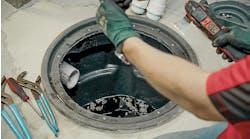MY AUGUST column about winterizing plumbing systems (pg. 44) generated a number of e-mails. Several questions were asked on using electric heat tapes.
A memory long tucked away in the back recesses of my mind rose to the surface: It was a bitter-cold winter, and the worksite was an egg farm that housed a number of dilapidated house trailers billed as a "Farm Vacation" for big-city dwellers. "Farm fresh eggs you can gather right from the hens."
I'd spent more time in the henhouse than I ever wanted while repairing water lines on previous visits, and I would bet that romantic notion of handpicking eggs was shattered the second an unsuspecting vacationer stepped over that threshold. The overwhelming ammonia from the decomposing chicken poop, deposited by several hundred thousand birds cramped three-toacage, was always an affront to the senses! There was also a horde of flies to contend with during warm weather.
Every winter during the worst weather, one or more of those mobile homes — a misnomer given their absence of wheels — would have its skirting blown away or forgotten-to-be-repaired, leaving a gap for old man winter's frosty breath. Since most of the trailers were unoccupied for weeks at a time, the first indication of things gone wrong was the river of ice greeting the lower-in-elevation office personnel.
Crawling under the trailer, through a sea of mud once I broke through the skin of ice, I was confronted with saturated fiberglass insulation that had been wrapped around the plastic piping. Once I removed it, I was shocked (quite literally) by the underlying heat tape. After a quick crawl, well — more like sliding along on my back given the quarters
being too cramped for crawling — I found the offending extension cord on the opposite side of the trailer and unplugged the darn thing. Lesson learned: always look first for unknown hazards!
Back to the mud slide. Once I uncovered the pipe, I realized the break wasn't due to freezing; it was from the heat tape overheating and subsequent blowout of heat-stressed plastic tubing. The heat tape itself was blackened and had apparently been in place for many years, given its cracked and missing outer jacket.
The weird piping created a challenge for repairs. I picked up a few heat tapes prominently displayed behind the supply house counter and a box of foamcell insulation that would look one heck of a lot more professional once the piping was covered. Back to the farm!
Once there, pipe repairs were made and new heat tape secured — just like the other one too — with the heat tape wrapped in a spiral pattern and then reversed to overlap its way back to use up the excess. And, no doubt, history would have repeated itself except for one thing. As I was sitting in the truck with the heater running full-blast, I gave my thawing fingers a task — to see if they could unfold the instructions. Like most trades-folk, I read instructions after installations! There it was in black and white — Warning: FIRE HAZARD — do not allow heat tape to overlap or cover with insulation.
I had to redo my own work at my own expense. Another graduate course in the School of Hard Knocks!
Which brings me back to the question posed by a first-time homeowner. She asked about applying heat tapes on water lines in an unheated crawl space at her vacation home.
"I've never owned a house before and currently live in an apartment. I was hoping not to have to drain the pipes and just leave the heat on at a low temperature. Would I need to insulate the pipes? It is a small house with a crawl space. What about the 'heat tape' method of protecting the pipes?"
As I explained to her, water lines in the crawl space can be insulated, which will help avoid condensation dripping during the summer and provide slight temporary protection from short-term freezing temps in the winter.
Continued exposure to sub-freezing temps will still result in frozen pipes and the potential for damage. If the crawl space can't be adequately protected, you can heat-trace the water lines.
A word of caution, however. Not all heat tapes are created equal and most present a potential fire hazard if they are not installed and used according to the instructions. The heat tape we use has a braided stainless steel exterior jacket housing a carbon-based inner core that self-regulates its heating. In other words, it only warms up as temperatures fall below 45°F and only where needed along its length. It can be overlapped and insulated without creating a fire hazard. Most cheap heat tapes can't be overlapped or insulated because they overheat and pose a real risk for fire. Heat tapes must be plugged into a GFCI circuit.
The Consumer Product Safety Commission estimates about 2,000 fires, 10 deaths and 100 injuries involving heat tapes occur each year.
All Dave Yates material on this website is protected by Copyright 2008. Any reuse of this material (print or electronic) must first have the expressed written permission of Dave Yates. Please contact via email at: [email protected]

